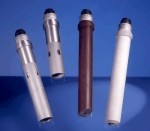
Contacting Conductivity Sensors SC42/SC4A
2016-05-27 13:17:48
Description:
Why measure Conductivity? It can be used as a fairly inexpensive and low maintenance indicator of water quality. Good quality water with little contaminants will have a low conductivity. There is far less maintenance than pH and minimal calibration. Conductivity is used in Boiler feedwater, RO, and Demineralizer applications. Since conductivity, up to a point, increases with an increase in the concentration of the ions in the process, we can use it to correlate to a % concentration value of solutions such as acids or bases. Again, since conductivity is non-specific, % concentration can only be measured on ONE chemical at a time and not a mixture of contributing chemicals. There are two basic sensor styles used for measuring Conductivity: Contacting and Inductive (Toroidal, Electrodeless). When Contacting Sensors are used, the conductivity is measured by applying an alternating electrical current to the sensor electrodes (that together make up the cell constant) immersed in a solution and measuring the resulting voltage. The solution acts as the electrical conductor between the sensor electrodes. The accuracy of conductivity measurements can be influenced by the following factors: Polarization. Contamination: Deposits or coating on the electrode surface of a 2-pole cell have a similar effect to polarization errors, i.e. the conductivity reading is lower than usual. These effects can also be prevented with a 4-pole conductivity cell. Cable resistance: The cable resistance can induce error in the measurement and must be taken into account. Temperature: Conductivity measurements are temperature dependent, if the temperature increases, conductivity increases.……
New Products
Siemens 6DL1193-6TP00-0DH1 SIMATIC ET 200SP HA
Siemens 6DL1193-6TP00-0DH1 SIMATIC ET 200SP HA, Terminal block, Type H1, 32 push-in terminals, internal reference temperature New load group, width: 22.5 mm.
Siemens 6DL1193-6TP00-0BH1 SIMATIC ET 200SP HA
Siemens 6DL1193-6TP00-0BH1 SIMATIC ET 200SP HA, Terminal block, Type H1, 32 push-in terminals, internal reference temperature Width: 22.5 mm.
Siemens 6DL1193-6GC00-0NN0 SIMATIC ET 200SP HA
Siemens 6DL1193-6GC00-0NN0 SIMATIC ET 200SP HA, carrier module 8-fold carrier for holding 8 I/O modules of the ET 200SP HA.
Siemens 6DL1193-6GA00-0NN0 SIMATIC ET 200SP HA
Siemens 6DL1193-6GA00-0NN0 SIMATIC ET 200SP HA, carrier module 2-fold carrier for holding 2 I/O modules of the ET 200SP HA.
Assortments
▶ Pressure Transmitter EJA
▶ Pressure Transmitters EJA-E
▶ Pressue Transmitter EJX
▶ Safety Instrumented System (SIS)
▶ Valve Positioners & Converters
▶ Field Mount Indicators
▶ Temperature Transmitters
▶ Magnetic Flowmeters
▶ Vortex Flowmeter
▶ Ultrasonic Flowmeters
▶ Coriolis Mass Flowmeters - ROTAMASS 3-Series
▶ Variable Area Flowmeters – Rotameters
▶ Device Smart Communicators
▶ PORTABLE AND HANDHELD INSTRUMENTS
▶ Distributed Control System (DCS)
▶ Process Analyzers
▶ Paperless Recorders
▶ Strip Chart Recorders
▶ Data Acquisition Equipment
▶ UT Series Temperature Controllers
▶ UP Series Program Controllers
▶ UM Series Digital Indicators with Alarms
▶ UT100 Series Temperature Controllers
▶ UD Series Manual Setters
▶ Limit Controllers
▶ YS Series Single-loop Controllers
Description
Contacting Conductivity Sensors SC42/SC4A
Why measure Conductivity?
It can be used as a fairly inexpensive and low maintenance indicator of water quality. Good quality water with little contaminants will have a low conductivity. There is far less maintenance than pH and minimal calibration. Conductivity is used in Boiler feedwater, RO, and Demineralizer applications.
Since conductivity, up to a point, increases with an increase in the concentration of the ions in the process, we can use it to correlate to a % concentration value of solutions such as acids or bases. Again, since conductivity is non-specific, % concentration can only be measured on ONE chemical at a time and not a mixture of contributing chemicals.
There are two basic sensor styles used for measuring Conductivity: Contacting and Inductive (Toroidal, Electrodeless).
When Contacting Sensors are used, the conductivity is measured by applying an alternating electrical current to the sensor electrodes (that together make up the cell constant) immersed in a solution and measuring the resulting voltage. The solution acts as the electrical conductor between the sensor electrodes.
The accuracy of conductivity measurements can be influenced by the following factors:
Polarization.
Contamination: Deposits or coating on the electrode surface of a 2-pole cell have a similar effect to polarization errors, i.e. the conductivity reading is lower than usual. These effects can also be prevented with a 4-pole conductivity cell.
Cable resistance: The cable resistance can induce error in the measurement and must be taken into account.
Temperature: Conductivity measurements are temperature dependent, if the temperature increases, conductivity increases.
| Model Code | SC42 Large Bore | SC4A | SC42 Small Bore |
|---|---|---|---|
| Cell Constants | 0.01/cm; 0.1/cm; 1.0/cm | 0.02/cm; 0.1/cm | 0.02/cm; 0.1/cm; 1.0/cm |
| Ranges | 0.02-2,000 µS/cm; 0.2-20,000 µS/cm; 2.0-200,000 µS/cm | 0.04-400 µS/cm; 0.2-2,000 µS/cm | 0.04-400 µS/cm; 0.4-2,000 µS/cm; 4.0-5,000 µ/cm |
| Temperature Element | Pt1000 | Pt1000 | Pt1000 |
| Pressure Rating | 10 bar/142 PSIG | 10 bar/142 PSIG | 7 bar/100 PSIG |
| Maximum Temperature | 150°C/302°F | 110°C/230°F | 100°C/212°F |
| Installation Connections | Requires FD40, FS40 or FF40 Holder | 3/4" NPT Fitting; 1", 1.5" or 2" Tri-Clamp; Retractable | 3/4" NPT Fitting; 1", 1.5" or 2" Tri-Clamp |
| Integral Cable | NO | YES | YES |
| Materials Of Construction | 316 Stainless Steel | 316 Stainless Steel or Titanium | 316 Stainless Steel or Titanium |
| Design Sytle | 2-Electrode | 2-Electrode | 2-Electrode |
